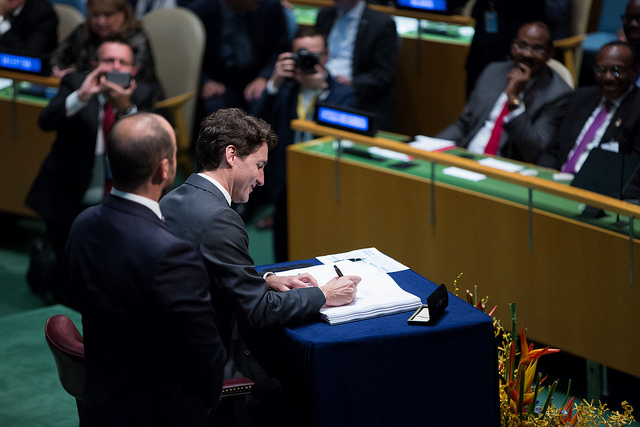This week marks the second anniversary of the Paris Agreement, the landmark climate deal committed to by nearly every country in the world. The notable exception is the United States, which has announced its intention to withdraw, but which procedurally cannot do so until 2020 (coincidentally, a day after the next presidential election). While a great deal of attention has been paid to the politics of the Agreement — who’s in and who’s out — the less dramatic, but equally important technical work on the nuts and bolts of implementation deserves a closer look.
At COP23, the recent United Nations climate change conference in Bonn, Germany, the Parties to the Agreement made good progress towards what is being called the “rulebook” for Paris: the rules, guidance, and procedures by which individual countries will agree to abide, in order to bring its objectives and principles into effect. While the Agreement itself sets the long-term vision, the rulebook (due for completion in 2018) will be necessary for countries to know how to make that vision operational, and to understand what will be expected of them in terms of requirements for communication and reporting, transparency and accountability, and review of collective efforts. This blog focuses on one aspect of the rulebook negotiations that stayed far outside the spotlight at COP23, but nonetheless possesses particular relevance for Canada: the development of guidance on Article 6.
What is Article 6?
In a nutshell, Article 6 is the part of the Paris Agreement that sets the framework for international cooperation to mitigate carbon pollution. Though it does not explicitly mention carbon pricing or emissions trading, it is the central piece of text governing countries’ use of international carbon markets in meeting their self-set climate targets (also known as their “nationally determined contributions,” or NDCs) for reducing domestic emissions.
More specifically, Article 6.1 of the Paris Agreement recognizes “that some Parties choose to pursue voluntary cooperation in the implementation of their nationally determined contributions to allow for higher ambition in their mitigation and adaptation actions and to promote sustainable development and environmental integrity.” This voluntary cooperation can take three forms: direct bilateral cooperation (Article 6.2), a new “sustainable development mechanism” (Article 6.4), or a non-market approach (Article 6.8).
Whatever the form — and there is ongoing debate as to how the three forms differ — fundamentally, Article 6 enables abatement measures taken in one country to be counted, through the concept of the “internationally transferred mitigation outcome” (ITMO), towards the achievement of another country’s NDC. And as 6.1 makes clear, it’s important to emphasize that these reduction-transfers must be voluntary, must have environmental integrity, and must enable countries to raise their mitigation ambition beyond what it otherwise would have been. In other words, countries can’t monetize emissions reductions that should occur anyway under their national climate strategy — they can only trade credits if the carbon pollution reduced by a given action is additional to existing plans.
Part of the rationale behind the cooperative mechanisms of Article 6 is that they should give countries the flexibility to pursue potentially lower-cost mitigation opportunities beyond their borders, and so increases the efficiency of global mitigation efforts. At the same time, they should open another avenue through which developing countries can access financing for projects.
However, ensuring greater efficiency without watering down ambition will require Article 6 transactions to be conducted transparently, with accurate accounting protocols that eliminate the possibility of double-counting. A country that sells or transfers a unit of reductions to an international buyer or recipient cannot then count that reduction towards its own target. Similarly, for the sake of good accounting and transparent review, negotiators will have to determine whether and how financial flows initiated under Article 6 deserve recognition as part of Parties’ overall climate finance contributions.
To its credit, Canada has stressed the need to avoid double-counting, and to ensure the environmental quality of ITMO units, in its thorough submissions to the COP23 process on Article 6.2 and Article 6.4.
Article 6’s relevance to Canada
Article 6 is likely to play an influential role in efforts to advance Canadian climate action. Keen observers of COP happenings will recall that French Foreign Affairs Minister Laurent Fabius, president of COP21 (where the Paris Agreement was created), tapped Minister Catherine McKenna to co-facilitate negotiations on market mechanisms during the second week of COP21. Canada has had a hand in Article 6 developments since the early days, and with good reason.
Despite important federal-provincial-territorial progress on climate policy implementation since Paris, the gap between our pledge to reduce emissions—30 per cent below 2005 levels by 2030 — and what current domestic policies are supposed to achieve is 44 Mt. ITMOs are a possible route to closing this gap, so Canada has an interest in ensuring the rules are administratively robust and environmentally trustworthy.
Article 6 is also important because it creates direct opportunities for private sector actors to participate in mitigation activities. In fact, the inclusion of market-based mechanisms within the Paris Agreement is largely due to the prospect that market flexibilities will enable countries to draw on the power of the private sector, scale their mitigation investments, and achieve more emissions cuts at lower overall costs.
Given its commitment to the development of Article 6, and its potential reliance on ITMOs, Canada should be at the forefront of the development of global carbon markets. It should model to the world not only how to do it well — ensuring environmental integrity and robust accounting — but also how it can be a crucial lever for raising our national climate ambition. So here’s hoping for Canada’s continued constructive efforts towards a completed rulebook at next year’s UN climate conference in Poland.











